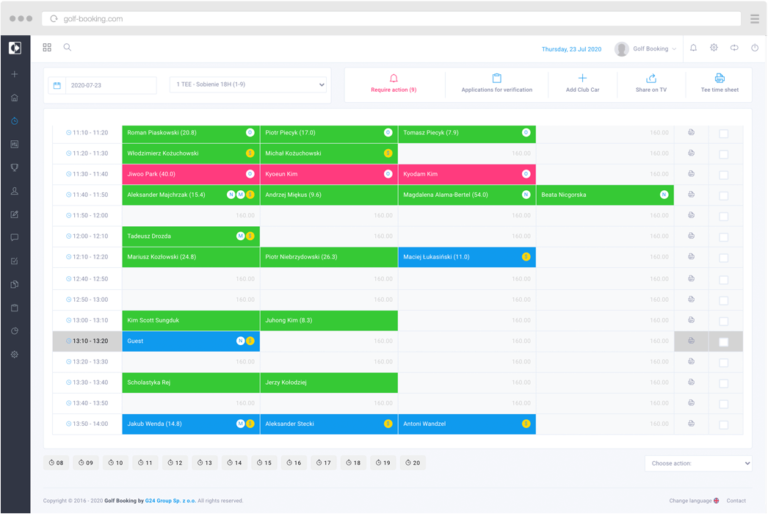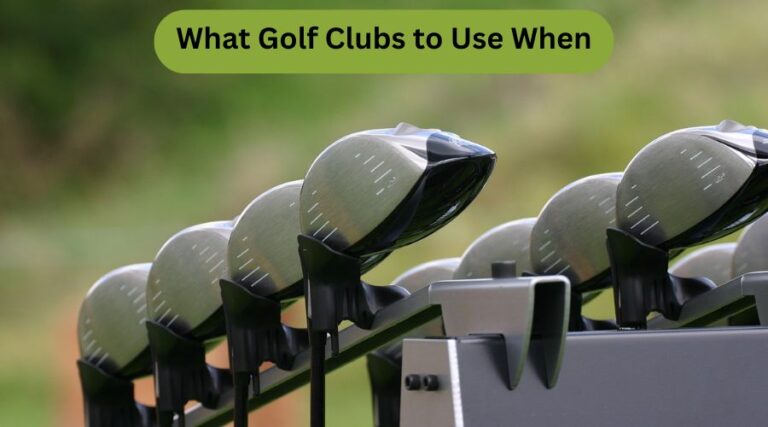A golfer should carry a mix of clubs including a driver, putter, irons, wedges, and possibly hybrids or woods. The ideal number and type vary based on skill level and playing style.
Crafting the perfect golf bag involves a strategic mix of clubs to tackle every shot on the course. Aspiring and seasoned golfers alike seek to optimize their game by selecting the right tools. Your golf bag should include a driver, a putter, a mix of irons (usually ranging from 3-iron to 9-iron), wedges for short-range precision, and fairway woods or hybrids for longer shots.
The exact composition depends on personal preference, playing conditions, and the golfer’s ability. It’s essential to balance distance coverage with shot versatility to handle the challenges of any golf course. Tailoring your club selection to your specific needs can help improve your game and lower your scores. Keep your choices well-rounded to ensure you’re prepared for a variety of shots, whether teeing off, approaching the green, or getting out of a tough lie.
Contents
Essential Golf Clubs For Your Bag
Starting your golf journey or looking to upgrade your set? Knowing which golf clubs to carry is key to your game. Each club has a unique role, from driving to putting. Pack your bag with these essentials and play with confidence. Remember, the right clubs can make all the difference on the course.
The Driver: Teeing Off with ConfidenceThe Driver: Teeing Off With Confidence
Every golfer needs a driver in their bag. It’s designed for maximum distance, helping you start each hole with a powerful tee shot. A good driver boosts your confidence and sets the tone for the game. Look for one with the right balance of loft and shaft flex to match your swing speed.
Fairway Woods: Versatility on the CourseFairway Woods: Versatility On The Course
Fairway woods are versatile clubs, perfect for long shots off the tee and from the fairway. They have a shallower face than drivers, making them easier to hit from various lies. Carry a couple of these to tackle different distances and situations on the course.
| Club | Use | Benefits |
|---|---|---|
| Driver | Tee shots | Long distance, high launch |
| Fairway Woods | Long fairway shots, tee shots on short holes | Versatility, easier to hit than long irons |
- Choose a driver that complements your swing.
- Include fairway woods for long-distance control.
- Test different drivers to find the best fit.
- Practice with fairway woods to master various shots.
Choosing Your Irons
Mastering your iron play can significantly improve your game. Each iron has a unique purpose on the course. Knowing which iron to use and when can make all the difference. Let’s delve into the world of irons and examine the key differences between long and short irons, and the role of hybrids.
Long Irons Vs. Short Irons: When To Use Each
Long irons and short irons serve different needs on the golf course. Long irons, typically ranging from 1 to 4, are designed for distance. They work well for shots off the tee on long par-3s or for reaching the green on par-5s. Short irons, from 7 to 9, are used for precision. They help with approach shots, getting the ball close to the pin.
- Long Irons:
- Harder to hit due to less loft
- Good for long, challenging shots
- Often replaced by hybrids
- Short Irons:
- Easier to control and loft
- Perfect for approach shots
- Provide higher accuracy
Hybrids: The Modern Alternative To Long Irons
Hybrids combine the best features of woods and irons. They offer an easy-to-hit alternative to long irons. With a hybrid, golfers get the distance of a long iron and the forgiveness of a wood. This makes hybrids a popular choice for golfers of all levels.
| Club Type | Features | When to Use |
|---|---|---|
| Hybrid | Forgiving, versatile, good for rough | Long shots, challenging lies |
| Long Iron | Less forgiving, more roll | Tee shots, long approaches |
Replacing long irons with hybrids can lead to better performance on the course. They help golfers hit higher, longer, and more accurate shots. Consider adding a hybrid or two to your bag for those tricky long-distance plays.
The Importance Of Wedges
Wedges are key for any golfer’s bag. They help control and precision in short games. Four types exist: pitching, gap, sand, and lob wedges. Each serves a specific purpose. Today, we focus on the pitching and sand wedges. These clubs make a huge difference on the course.
Pitching Wedge: Your Go-to For Short Shots
The pitching wedge is essential for short-range play. It’s perfect for shots from 100 yards and in. Most golfers use it for approach shots on the green. It has a loft between 44° and 49°. This makes it great for high, short shots that land with precision.
- Highly versatile for various shots
- Essential for chip-and-run shots
- Can be used in sand bunkers with firm sand
Sand Wedge: Escaping Bunkers With Ease
The sand wedge is designed for getting out of bunkers. Its loft is usually between 54° and 58°. This helps the ball to lift quickly in sandy situations. The sand wedge also works well for soft lies and high lob shots.
| Club | Loft | Use Case |
|---|---|---|
| Pitching Wedge | 44°-49° | Approach shots, chip-and-runs |
| Sand Wedge | 54°-58° | Bunkers, soft lies, lob shots |
Specialty Clubs
The right selection of specialty clubs can greatly enhance your golf game. These clubs are designed for specific situations on the course.
Lob Wedge: Mastering Delicate Shots
Lob wedges excel in high-precision situations. They offer a steep angle for shots that need to rise quickly and land softly.
- High loft: Typically ranging from 58° to 62°.
- Short game: Ideal for clearing obstacles close to the green.
- Soft landing: Minimizes ball roll, enhancing control.
Gap Wedge: Filling The Distance Gaps
The gap wedge bridges the distance between a pitching wedge and a sand wedge.
| Club | Loft | Typical Use |
|---|---|---|
| Gap Wedge | 50° to 54° | Filling distance gaps in the short game |
Use this club for mid-range shots where precision is key.
The Putter: Perfecting The Final Stroke
Mastering the putter is crucial for any golfer’s success. This club determines the fate of the ball in those final, tension-filled moments. A steady hand and the right putter can make all the difference between victory and defeat.
Putter Types: Finding The Right Fit
Selecting the ideal putter is a unique journey for every golfer. The right fit depends on personal preference and playing style.
- Blade Putters: Great for players with a straight putting stroke.
- Mallet Putters: Offer more forgiveness and suit a curved stroke.
- Face-Balanced: Ideal for those who keep the putter face square.
- Toe-Balanced: Better for an arc stroke.
Putter Techniques: Improving Your Short Game
With the right putter in hand, technique is your next focus. A good short game can dramatically lower your scores.
- Keep Your Eyes on the Ball: This ensures a solid contact point.
- Stay Relaxed: Tension can throw off your stroke.
- Practice Consistency: Regular practice builds muscle memory.
Remember: Consistent putting turns good players into great ones.
Maximizing Your Club Count
Choosing the right golf clubs is a game-changer. Carry the perfect mix to hit every shot you need. Let’s dive into the 14-club rule and craft the ideal set for you.
The 14-club Rule: Understanding The Limit
Golf rules allow only 14 clubs in your bag. Picking the right ones is crucial. Mix drivers, woods, irons, wedges, and a putter for the best set.
- Drivers for long, straight shots off the tee.
- Woods for distance shots with more control.
- Irons for a range of shots from tee to green.
- Wedges for precision on short shots and out of sand.
- Putter for the green and sinking the ball.
Club Selection Strategy For Different Skill Levels
Your skill level shapes your club choices. Beginners need clubs that offer forgiveness. Advanced players choose clubs for more precision and control.
| Skill Level | Club Selection |
|---|---|
| Beginners | Larger club heads, higher lofts, and flexible shafts to help with off-center hits. |
| Intermediate | A mix of game-improvement irons and player’s clubs for better shot shaping. |
| Advanced | Clubs that focus on control, lower trajectories, and maneuverability. |
Customizing Your Club Set
Customizing Your Club Set is key to enhancing your game.
Select clubs that match your specific needs.
Assessing Your Play Style And Course Types
Understand your play style to choose the right clubs.
- Do you prefer long shots or short games?
- Are your courses more open or filled with obstacles?
Choose clubs based on these answers.
Beginner Vs. Advanced: Tailoring Your Club Choices
Each skill level needs different clubs.
| Level | Essential Clubs | Optional Clubs |
|---|---|---|
| Beginner | Driver, Putter, Irons | Hybrids, Specialty Wedges |
| Advanced | Driver, Putter, Irons, Wedges | Performance Hybrids, Additional Wedges |
Beginners focus on fundamentals with fewer clubs.
Advanced players use more clubs for game refinement.
Maintenance And Care
Golf clubs are prized assets on the green. Proper maintenance and care keep them performing at their best. This guide outlines essential tips for keeping your golf clubs in top condition and knowing when to upgrade them.
Cleaning And Storage: Keeping Clubs In Top Shape
Regular cleaning and correct storage are key to a club’s longevity. Dirt and debris can affect a club’s performance. Here’s a simple routine:
- Wash the heads with warm, soapy water.
- Scrub the grooves with a soft-bristled brush.
- Rinse and dry thoroughly.
- Store clubs in a dry, temperature-controlled environment.
When To Replace: Signs Your Clubs Need An Upgrade
Clubs don’t last forever. Here’s what to watch for:
| Sign | Meaning |
|---|---|
| Worn Grips | Loss of traction can lead to inconsistency. |
| Damaged Shaft | Bent or dented shafts affect swing accuracy. |
| Loose Heads | Club heads that move on the shaft compromise shots. |
| Performance Drop | If shots are not as crisp, it could be time for new clubs. |
Frequently Asked Questions
How To Figure Out What Golf Clubs To Buy?
Consider your skill level and typical golf course conditions. Assess your playing style and distance needs. Get fitted by a professional for proper club specifications. Prioritize essential clubs, starting with a driver, putter, and irons. Read reviews and test different brands for comfort and performance.
How Do I Know Which Golf Club To Use?
Select your golf club based on distance to the hole and your personal shot distance with each club. Use drivers for long-range shots, irons for precision, and putters for the green. Experiment to find your comfort with each club’s range.
Does A 4 Hybrid Go Further Than A 4 Iron?
Yes, a 4 hybrid typically goes further than a 4 iron due to its design and ease of use.
How Many Clubs Should I Carry?
Golfers should carry a maximum of 14 clubs in their bag, as per the official rules of golf.
Conclusion
Choosing the right golf clubs for your bag doesn’t have to be overwhelming. Start with the essentials like a reliable driver, putter, and a set of irons tailored to your skill level. Don’t forget to include a few wedges and perhaps a hybrid for versatility.
Remember, the key is to focus on what will improve your game and enhance your experience on the course. Equip yourself wisely, and enjoy every round!






